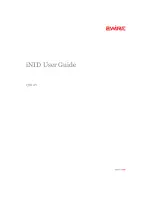Tempo can be set and displayed in either rhythmic value or time values. Many
presets, particularly the Rhythmic Echo & Delay Effects in Program Bank P1,
have delay times assigned to Tap tempo. Try loading some of these and
pressing Tap twice in rhythm to change tempo.
An enormous range of editing control is provided for each algorithm, with
parameters organized in an edit matrix of as many as 100 main controls. In
addition to providing this powerful sound design capability, the PCM 80 also
allows you to customize these controls for your day-to-day editing needs, or to
use a subset of controls specially designed for each preset.
The PCM 80 has two levels of Edit Mode control called Go mode and Pro mode.
In Go mode, the most useful parameters within an effect are grouped for instant
access via the front panel Edit button. Each preset has a specially selected set
of Go mode parameters which let you make value changes to the effect without
losing the character of the sound. Pro mode gives you access to the full
parameter editing matrix for the algorithm of any loaded effect when you press
Edit. In this mode, you can access a complete set of Modulation and Patching
parameters, create your own ADJUST knob patch and assign your own Go
mode parameters.
A unique Patching and Modulation system provides unprecedented control over
your effects, with a versatile set of internal modulators: LFO, AR Envelope,
Envelope Follower, Latch and Time Switches. These allow you to create
modulation sweeps which move in time with music, or wildly animated effects.
You can create as many as 10 patches per effect, each with as many as 8 pivot
points. You can patch multiple parameters to a single controller, or patch
multiple sources to a single destination.
The front panel memory slot will accept industry standard PCMCIA SRAM cards
(up to 1Meg). Use these cards to store effects (as many as 2350 on a 1 Meg
card), system setups, MIDI program maps, and more.
PCM 80 internal audio memory can be expanded from a maximum stereo delay
time of 2.6 seconds to more than 42 seconds by installing 4Meg memory
modules (SIMMs).
For all of its programming power and flexibility, you’ll find the PCM 80 simple to
use. The large, 2-line fluorescent display is easy to see from any angle whether
the surroundings are bright or dark. Separate SELECT and ADJUST knobs
make program loading and editing quick and easy. We’ve even designed in a
special Info mode — press and hold any button to find out what its function is,
or to get status information such as the name of the running effect, current tempo
rate, etc.
To get the most out of the PCM 80, we suggest that you invest the time to explore
this manual. We think you’ll agree that the time spent investigating will reward
you with enjoyment of its full capabilities.
Editing
Expansion
User Interface
Summary of Contents for PCM 80
Page 1: ...User Guide Digital Effects Processor PCM 80 ...
Page 3: ...User Guide Digital Effects Processor PCM 80 ...
Page 11: ...1 1 Product Overview 1 Product Overview Block Diagram ...
Page 69: ...3 11 The Algorithms and Their Parameters Chorus Rvb cont d ...
Page 71: ...3 13 The Algorithms and Their Parameters M Band Rvb cont d ...
Page 96: ...Lexicon 3 38 PCM 80 User Guide ...
Page 118: ...Lexicon 4 22 PCM 80 User Guide ...
Page 128: ...Lexicon 5 10 PCM 80 User Guide ...


















